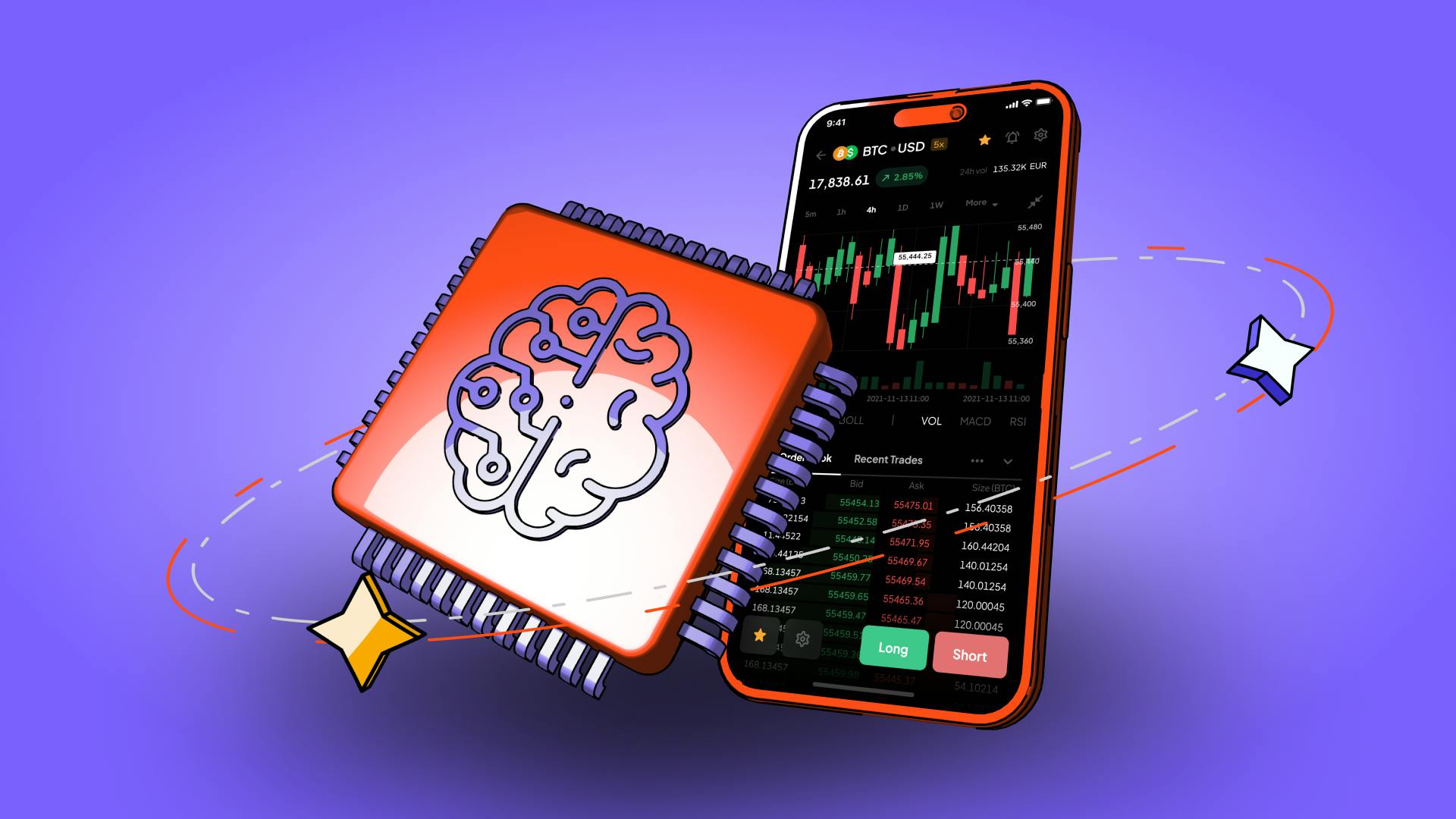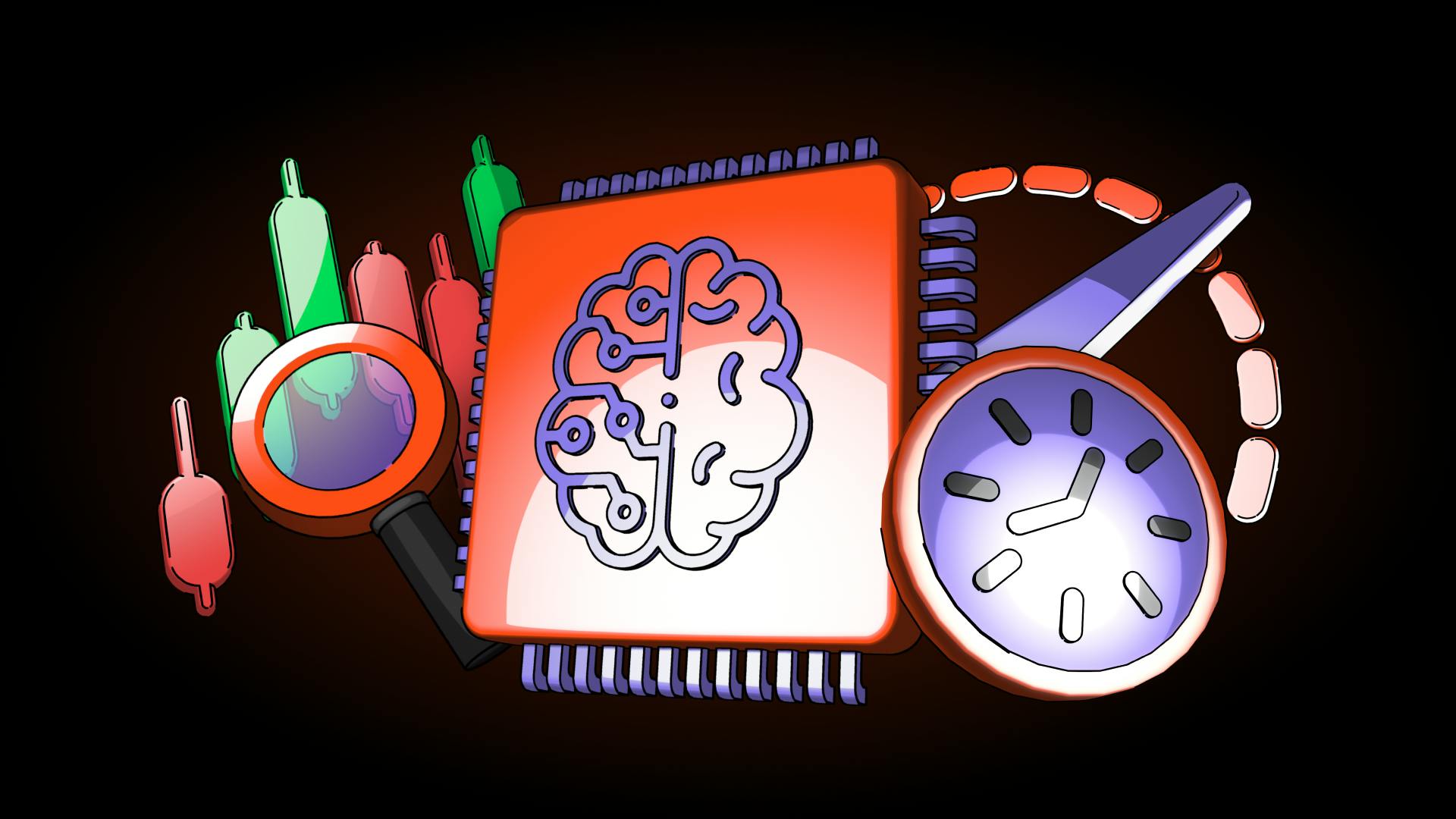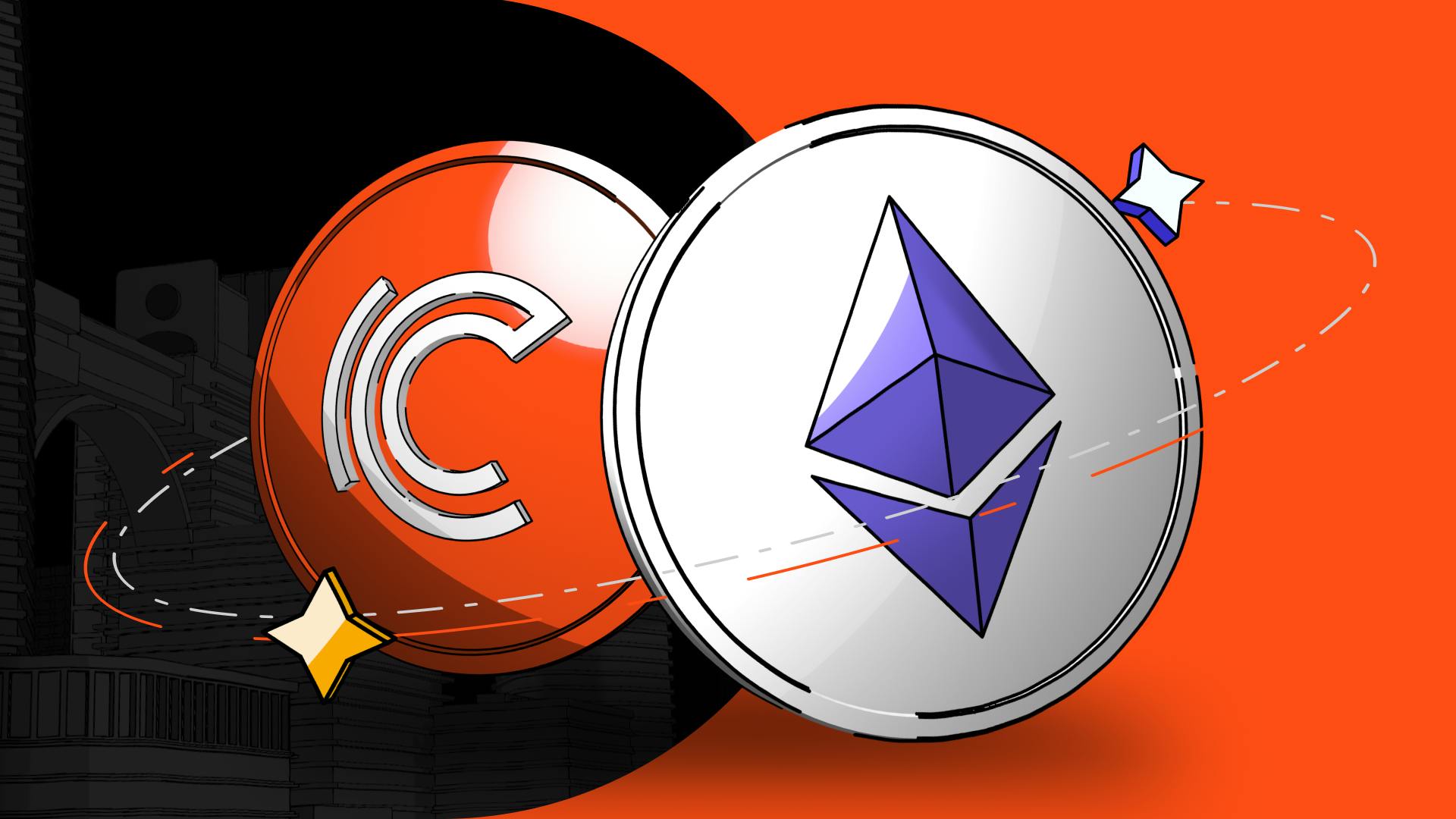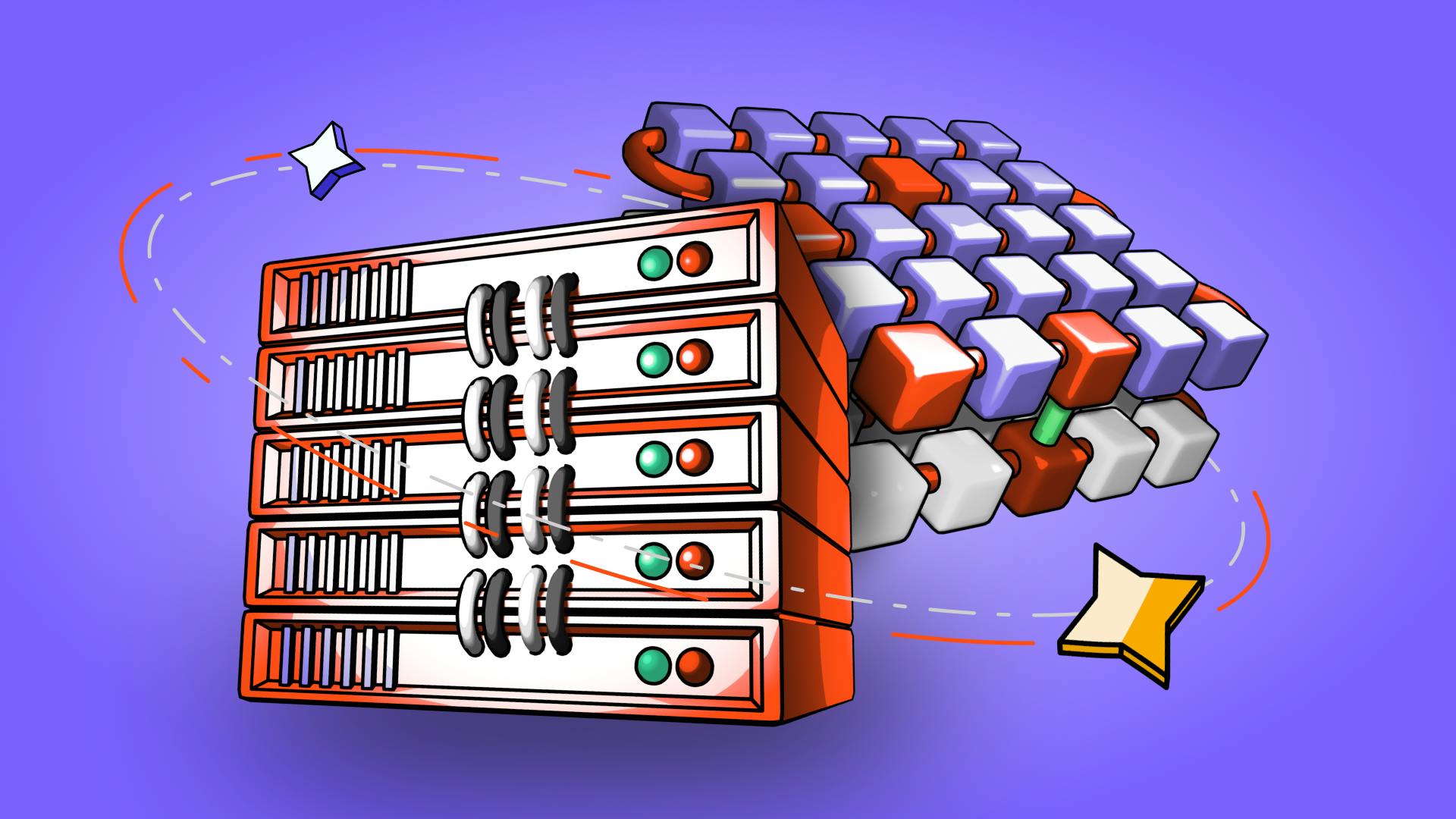Negociação de Criptomoedas com IA: A Ascensão das Estratégias Algorítmicas Avançadas
28 de outubro de 2025

by Coinmetro Editorial Team
28 de outubro de 2025
A inteligência artificial tem o potencial de transformar a negociação de criptomoedas através de uma melhor análise de mercado e decisões mais rápidas. Ferramentas inteligentes como o machine learning e as redes neurais processam grandes volumes de dados rapidamente, ajudando os traders a identificar oportunidades com precisão. Isto torna a negociação potencialmente mais eficiente e lucrativa. Mas, se todos os traders usassem IA, continuaria a existir uma vantagem competitiva?
Este artigo analisa o papel da IA nas estratégias de negociação de criptomoedas. Explora como as ferramentas baseadas em IA estão a redefinir as estratégias de trading, destaca os seus benefícios e discute os algoritmos avançados que ajudam os traders a obter uma vantagem competitiva num mercado de criptomoedas altamente volátil.
A negociação de criptomoedas com IA utiliza a inteligência artificial para orientar decisões no mercado de criptomoedas. Estes sistemas recorrem a aprendizagem automática (machine learning), redes neurais e análise de dados para estudar tendências. Além disso, conseguem prever variações de preço e executar transações automaticamente, sem intervenção humana.
Machine Learning: Esta ferramenta aprende com dados passados para melhorar as previsões. Processa grandes volumes de informação rapidamente, identificando padrões que os traders humanos muitas vezes não percebem. Estes modelos utilizam métodos estatísticos para detetar tendências, ajudando a melhorar as decisões de negociação.
Redes Neurais: Parte fundamental do machine learning, lidam com padrões de dados complexos. Inspiradas no funcionamento do cérebro humano, são especialmente eficazes em associar preços, indicadores e outros fatores. No mercado cripto, permitem prever movimentos com maior precisão.
Análise de Dados: Examina grandes conjuntos de dados para revelar informações ocultas. Na negociação, processa dados de mercado, redes sociais e detalhes da blockchain. A IA utiliza estas informações para ajustar estratégias rapidamente e gerir riscos de forma eficaz.
Ao combinar estas ferramentas, os sistemas de negociação com IA conseguem aumentar a precisão e a velocidade, oferecendo aos traders uma vantagem competitiva e ajudando-os a prosperar num mercado de criptomoedas volátil.
A negociação algorítmica começou nos mercados tradicionais há várias décadas. Na década de 1960, Ed Thorp foi pioneiro na arbitragem com computadores, dando forma à automação inicial. Os anos 1970 introduziram sistemas de cotação de ações e as ferramentas de dados de mercado da NYSE.
Nos anos 1980, as redes de comunicação eletrónica (ECNs), como a Instinet, permitiram a ligação eletrónica entre grandes investidores. A Renaissance Technologies, fundada em 1982, baseou as suas negociações em modelos matemáticos complexos. A década de 1990 trouxe o trading de alta frequência (HFT), com acesso mais rápido aos mercados.
Os mercados de criptomoedas adotaram a negociação algorítmica no início da década de 2010. Os traders adaptaram estratégias tradicionais às fortes oscilações e ao funcionamento contínuo do mercado cripto. Isso criou oportunidades de arbitragem entre várias exchanges.
A inteligência artificial agora impulsiona essas táticas na negociação de criptomoedas. O machine learning processa rapidamente dados de preços, volumes e redes sociais, ajustando estratégias em tempo real e oferecendo aos traders uma vantagem competitiva.
Aprende Sobre Arbitragem de Criptomoedas: Técnicas e Ferramentas para Traders

Eficiência e Velocidade: Os algoritmos de IA executam negociações de criptomoedas muito mais rapidamente do que os humanos. Analisam dados de mercado e aproveitam oportunidades em milissegundos. Esta velocidade ajuda os traders a lucrar com pequenas variações de mercado. As estratégias de negociação de alta frequência (HFT), que dependem da execução ultrarrápida de ordens, são um excelente exemplo de como a IA melhora a eficiência do trading.
Decisões Baseadas em Dados: A IA processa grandes volumes de dados de mercado para orientar as decisões de negociação. Analisa preços, volumes e informações de redes sociais para identificar tendências. O machine learning aprimora as previsões ao longo do tempo, reduzindo o viés emocional.
Negociação 24/7: A negociação de criptomoedas com IA funciona de forma contínua, ao contrário dos traders humanos. Monitoriza os mercados voláteis 24 horas por dia, aproveitando todas as oportunidades. Esta atividade constante pode aumentar os lucros durante as fortes oscilações do mercado cripto.
Estas estratégias algorítmicas avançadas utilizam o poder da IA para otimizar a negociação, oferecendo aos traders ferramentas que aumentam a eficiência e a rentabilidade no mercado de criptomoedas:
Arbitragem: A arbitragem na negociação de criptomoedas explora as diferenças de preço do mesmo ativo entre várias exchanges. Os bots analisam múltiplas plataformas e detetam instantaneamente essas discrepâncias. Compram a um preço mais baixo numa exchange e vendem a um preço mais alto noutra, garantindo lucros em segundos — muito mais rápido do que qualquer ser humano conseguiria.
Grid Trading: O grid trading define ordens de compra e venda em intervalos fixos em torno de um preço base. Isto forma uma “grelha” que permite lucrar com oscilações de preço dentro de uma faixa. Em mercados voláteis, os bots executam estas ordens automaticamente, comprando a preços baixos e vendendo a preços altos de forma consistente.
Market Making: O market making melhora a liquidez ao colocar ordens de compra e venda de um ativo. Os bots lucram com o spread bid-ask, ou seja, a diferença entre o preço de compra e o de venda. Ajustam as ordens conforme as variações do mercado, ajudando a estabilizar os preços enquanto geram ganhos constantes.
Dollar-Cost Averaging: A estratégia de investimento programado (DCA) consiste em investir uma quantia fixa em criptomoedas em intervalos regulares, ignorando as variações de preço. A IA automatiza este processo, distribuindo as compras para reduzir o impacto da volatilidade. Com o tempo, esta abordagem pode diminuir o custo médio por unidade e reduzir o risco de investir no momento errado.
Maximiza os Teus Lucros com os Melhores Bots de Negociação de Criptomoedas com IA
A volatilidade da negociação de criptomoedas exige uma gestão de risco rigorosa para proteger o capital. Ferramentas como ordens de stop-loss, dimensionamento de posições e diversificação reduzem os riscos de forma eficaz:
Ordens de Stop-Loss: As ordens de stop-loss acionam uma venda quando o preço de um ativo atinge um valor mínimo definido. Isto limita as perdas e ajuda a conter decisões emocionais durante quedas de mercado. A automação mantém a disciplina e protege o investidor.
Dimensionamento de Posições: O dimensionamento de posições define o tamanho das transações com base na tolerância ao risco e na dimensão do portefólio. Esta técnica limita a sobreexposição a um único ativo, equilibrando o risco. Com um bom dimensionamento, os traders mantêm a estabilidade mesmo sob pressão.
Diversificação de Estratégias: A diversificação distribui os investimentos por vários ativos e táticas, reduzindo o impacto de falhas isoladas. Esta abordagem pode diminuir o risco enquanto aumenta as hipóteses de ganhos consistentes no portefólio. A estabilidade tende a crescer com uma diversificação bem estruturada.
O uso de IA na negociação levanta várias preocupações éticas, especialmente no que diz respeito à manipulação de mercado e ao uso responsável da tecnologia:
Manipulação de Mercado: As negociações rápidas e em grande volume executadas pela IA podem abrir caminho para manipulação de mercado. O spoofing — prática que consiste em colocar ordens falsas para alterar os preços dos ativos — ameaça a equidade e a integridade do mercado. Regulamentações rigorosas e princípios éticos sólidos são essenciais para impedir que a IA facilite este tipo de comportamento.
Uso Ético da IA: A negociação ética com IA baseia-se na transparência, responsabilidade e justiça para todos os participantes. Os traders devem ter uma compreensão clara de como a IA seleciona as suas operações, incluindo a lógica e os dados que utiliza. A responsabilidade deve ser partilhada entre os programadores e os utilizadores, acompanhada por registos detalhados das ações da IA.
Uma IA responsável evita manipulação e vantagens desleais nos mercados. O spoofing engana outros investidores ao criar sinais de preço falsos e distorcer as condições de mercado. A negociação de alta frequência que provoca flash crashes desestabiliza os mercados, pelo que uma supervisão rigorosa é necessária para garantir que a IA contribui para uma negociação justa e estável.
À medida que as ferramentas de IA e aprendizagem automática se tornam mais comuns na negociação de criptomoedas, é essencial compreender as possíveis consequências da sua adoção generalizada por todos os participantes do mercado:
Eficiência e Previsibilidade do Mercado: Quando muitos traders utilizam as mesmas ferramentas de IA, a eficiência do mercado pode aumentar. Os algoritmos explorariam e corrigiriam rapidamente discrepâncias de preços, reduzindo as margens e as oportunidades de arbitragem. Isso poderia tornar os mercados mais previsíveis, mas também menos lucrativos para quem depende de estratégias tradicionais.
Comportamento de Manada e Volatilidade: O uso uniforme da IA pode levar a comportamentos de manada. Se uma IA emitir um sinal de compra ou venda, todos os utilizadores podem reagir ao mesmo tempo, provocando oscilações súbitas nos preços e aumento da volatilidade. Por exemplo, se uma IA prever uma queda e ativar ordens de venda em massa, isso pode causar uma descida rápida de preços e até desencadear um crash de mercado.
Diminuição da Diversidade de Estratégias: A falta de diversidade estratégica pode conduzir à estagnação do mercado. Quando todos utilizam as mesmas ferramentas, as abordagens inovadoras e diversificadas de negociação diminuem. Esta redução da diversidade pode tornar o mercado menos dinâmico e mais vulnerável a riscos sistémicos.
Riscos da Negociação Algorítmica: Os modelos de IA não são infalíveis. Podem cometer erros ou ser influenciados por dados incorretos. Se muitos traders utilizarem o mesmo modelo defeituoso, o impacto desses erros pode ser amplificado. Exemplos históricos, como o Flash Crash de 2010, mostram como falhas na negociação algorítmica podem causar perturbações significativas no mercado.
Preocupações Regulatórias e Éticas: Como mencionado anteriormente, o uso generalizado de ferramentas de IA idênticas levanta questões éticas e regulatórias. As autoridades poderão precisar de garantir que estas ferramentas são utilizadas de forma justa e não criam vantagens indevidas ou riscos sistémicos. Garantir transparência e responsabilidade nas operações de IA será essencial para manter a confiança nos mercados financeiros.
Sobreajuste e Degradação dos Modelos: Os modelos de IA treinados com dados históricos podem tornar-se menos eficazes ao longo do tempo se não forem atualizados e ajustados continuamente. Se muitos participantes utilizarem os mesmos modelos estáticos, poderão sofrer coletivamente de overfitting, em que o modelo funciona bem com dados passados, mas mal com dados futuros e imprevistos.
Estagnação da Inovação: A adoção generalizada de ferramentas de IA idênticas pode travar a inovação nas estratégias de negociação. Os traders e as empresas podem tornar-se excessivamente dependentes dessas ferramentas, reduzindo o incentivo para desenvolver métodos novos e proprietários que poderiam oferecer uma vantagem competitiva.
A IA tem o potencial de melhorar significativamente a negociação de criptomoedas, aumentando a eficiência, a velocidade e a precisão das estratégias. A aprendizagem automática, as redes neurais e a análise de dados capacitam os traders para tomarem decisões inteligentes a qualquer hora. Isto pode aumentar a disciplina e eliminar a emoção do processo de negociação.
No entanto, o uso generalizado de ferramentas de IA pode aumentar a volatilidade, reduzir a diversidade de estratégias e introduzir riscos sistémicos. Princípios éticos como transparência, responsabilidade e justiça devem garantir que a IA atua de forma íntegra, prevenindo manipulações de mercado.
À medida que avançamos, traders e reguladores devem equilibrar as vantagens da IA com os riscos potenciais. Ao promover a inovação e manter padrões éticos sólidos, a indústria de negociação de criptomoedas pode utilizar a IA para criar um mercado mais eficiente, justo e rentável.
▶️ Assiste: Pode a IA Criar Estratégias de Negociação Bem-Sucedidas?
Junte-se à comunidade Coinmetro no Discord e Telegram, onde traders e investidores visionários se reúnem para compartilhar conhecimentos, explorar novas oportunidades e mergulhar profundamente em criptomoedas. Se precisar de ajuda, entre em contato com a nossa equipe de suporte ao cliente de classe mundial através do chat ao vivo 24/7 ou por e-mail para hello@coinmetro.com.
Para se tornar um utilizador Coinmetro hoje, Registre-se agora, ou aceda à nossa nova Bolsa se já estiver registrado para experimentar nossa plataforma de negociação premium.
Etiquetas
Artigos relacionados

Influenciadores de Criptomoedas a Seguir em 2024: Quem Está a Moldar o Mercado?
Os influenciadores de criptomoedas desempenham um papel fundamental no mercado de moedas digitais. Eles orientam os investidores com perceções…
9m

Empréstimos e Empréstimos DeFi: Um Guia para Principiantes
As DeFi (Finanças Descentralizadas) utilizam a tecnologia blockchain para oferecer serviços financeiros sem bancos. Plataformas como Ethereum, Solana…
9m

How to Stake Ethereum (ETH) on Coinmetro Fast, Easy, and Securely
Quer ganhar rendimento passivo com o seu Ethereum? Com a Coinmetro, fazer staking de ETH é simples, seguro e ideal para principiantes. Neste guia…
2m

O Futuro das Soluções Descentralizadas de Largura de Banda e Armazenament
A era digital impulsiona a criação de dados, exigindo soluções seguras e escaláveis para a sua gestão. Os sistemas centralizados de largura de banda…
7m